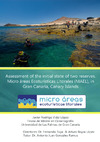Please use this identifier to cite or link to this item:
https://accedacris.ulpgc.es/jspui/handle/10553/12660
| DC Field | Value | Language |
|---|---|---|
| dc.contributor.advisor | González Ramos, Antonio Juan | - |
| dc.contributor.advisor | Tuya Cortés, Fernando José | - |
| dc.contributor.advisor | Boyra López, Arturo | - |
| dc.contributor.author | Vidal López, Javier Rodrigo | - |
| dc.contributor.other | Facultad de Ciencias del Mar | en_US |
| dc.date.accessioned | 2015-01-13T03:30:20Z | |
| dc.date.accessioned | 2018-05-15T10:49:55Z | - |
| dc.date.available | 2015-01-13T03:30:20Z | |
| dc.date.available | 2018-05-15T10:49:55Z | - |
| dc.date.issued | 2014 | en_US |
| dc.identifier.uri | https://accedacris.ulpgc.es/handle/10553/12660 | |
| dc.description.abstract | The establishment of 'Micro áreas ecoturísticas litorales' (MAELs) is a new strategy of marine conservation and management, based on a bottom-up governance strategy. In this study, we assessed the initial state ('state 0') of two MAELs at Gran Canaria Island (Canary Islands): 'El Cabrón' and 'Las Canteras', located in the east and in north-east coast of Gran Canaria Island, respectively. Specifically, we evaluated differences in the abundance and biomass of target fish species between inside (MAELI) and outside (MAELO) these two proposed reserves; five commercially-targeted fish species were selected: the parrotfish, Sparisoma cretense, the white sea-bream, Diplodus sargus cadenati, the common two-banded sea-bream, Diplodus vulgaris, the island grouper, Mycteroperca fusca, and salema, Sarpa salpa. Fish assemblages were sampled at 7 times within each management category in during summer and autumn of 2013. Univariate tests provided an overall moderate ‘reserve effect’ for the initial state of both MAELs. Mycteroperca fusca and Diplodus vulgaris showed greater abundances and biomasses, respectively, within the ‘El Cabrón’ MAELI compared to the adjacent MAELO. Sparisoma cretense, Diplodus sargus cadenati, Diplodus vulgaris and Sarpa salpa showed greater abundances and biomasses within the 'Las Canteras' MAELI compared to the adjacent MAELO. Furthermore, we tested whether taxonomic diversity (through calculation of the Shannon diversity index for the entire fish assemblage) may be a surrogate for the trophic and functional diversity of the fish assemblage to adequately support the capacity of MAMPs to preserve marine biodiversity. Our data suggested a neat link between them. | en_US |
| dc.description.abstract | "Micro áreas ecoturísticas litorales" (MAELs) es una nueva estrategia de gestión y conservación marina, basada en la estructura de decisión bottom-up. En este estudio, evaluamos el estado inicial ('estado 0') de dos MAELs en Gran Canaria (Islas Canarias). 'El Cabrón' y 'Las Canteras', localizadas en este y noreste de la isla de Gran Canaria, respectivamente. Específicamente, evaluamos diferencias en abundancia y biomasa de especies de peces objetivo-comerciales, dentro (MAELI) y fuera (MAELO) de las dos reservas propuestas; Las cinco especies comerciales estudiadas fueron: Sparisoma cretense, Diplodus sarguscadenati, Diplodus vulgaris, Mycteroperca fusca y Sarpa salpa. Las poblaciones de pecesfueron muestreadas durante 7 tiempos comprendidos entre verano y otoño de 2013. Tests univariantes mostraron un moderado 'efecto reserva' durante el estado inicial de las dos MAELS. Mycteroperca fusca y Diplodus vulgaris mostraron mayores abundancias y biomasas, respectivamente, dentro ‘El Cabrón’ MAELI comparadas con la zona adyacente MAELO. Sparisoma cretense, Diplodus sargus cadenati, Diplodus vulgaris y Sarpa salpa mostraron mayores abundancias y biomasas dentro de 'Las Canteras' MAELI comparado con la zona adyacente MAELO. Además, testamos si la diversidad taxonómica (mediante el cálculo del índice de diversidad de Shannon para la población de peces) puede estar relacionada con la diversidad trófica y funcional de la población de peces para evaluar la capacidad de preservar la biodiversidad marina de las MAMPs. Encontramos en nuestros datos una unión entre ellas. | en_US |
| dc.format | application/pdf | es |
| dc.language | eng | en_US |
| dc.rights | by-nc-nd | es |
| dc.subject | 590208 Política del medio ambiente | en_US |
| dc.subject | 531290 Economía sectorial: turismo | en_US |
| dc.subject.other | Micro áreas marinas protegidas | en_US |
| dc.subject.other | MAMPS | en_US |
| dc.subject.other | Diversidad funcional | en_US |
| dc.subject.other | Diversidad trófica | en_US |
| dc.subject.other | Diversidad taxonómica | en_US |
| dc.title | Assessment of the initial state of two reserves, Micro áreas Ecoturísticas Litorales (MAEL), in Gran Canaria, Canary Islands | en_US |
| dc.type | info:eu-repo/semantics/masterThesis | en_US |
| dc.type | MasterThesis | en_US |
| dc.compliance.driver | 1 | es |
| dc.contributor.departamento | Departamento de Biología | en_US |
| dc.contributor.facultad | Facultad de Ciencias del Mar | en_US |
| dc.identifier.absysnet | 702507 | es |
| dc.identifier.crisid | - | |
| dc.investigacion | Ciencias | en_US |
| dc.rights.accessrights | info:eu-repo/semantics/openAccess | es |
| dc.type2 | Trabajo final de máster | en_US |
| dc.description.notas | Máster en Oceanografía ; 2013-2014 | en_US |
| dc.utils.revision | Sí | en_US |
| dc.identifier.matricula | TFT-29457 | es |
| dc.identifier.ulpgc | Sí | en_US |
| dc.contributor.buulpgc | BU-BAS | en_US |
| dc.contributor.titulacion | Máster Universitario en Oceanografía | es |
| item.fulltext | Con texto completo | - |
| item.grantfulltext | open | - |
| crisitem.advisor.dept | GIR ECOAQUA: Biodiversidad y Conservación | - |
| crisitem.advisor.dept | IU de Investigación en Acuicultura Sostenible y Ec | - |
| crisitem.advisor.dept | Departamento de Biología | - |
| crisitem.advisor.dept | GIR ECOAQUA: Biodiversidad y Conservación | - |
| crisitem.advisor.dept | IU de Investigación en Acuicultura Sostenible y Ec | - |
| crisitem.advisor.dept | Departamento de Biología | - |
| Appears in Collections: | Trabajo final de máster | |
Page view(s)
126
checked on Mar 1, 2025
Download(s)
83
checked on Mar 1, 2025
Google ScholarTM
Check
Share
Export metadata
Items in accedaCRIS are protected by copyright, with all rights reserved, unless otherwise indicated.
